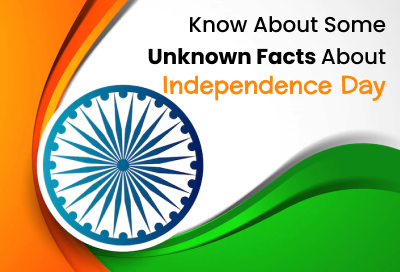
Independence Day is celebrated with great zeal and shows throughout the country every year on 15 August. This big and significant day is a remembrance for every citizen of India of starting a new era of release from British colonialism that ruled for about 200 years. The Indian struggle a lot for independence was an exhausting and lengthy one.
Independence Day is undoubtedly a sentimental day for the Indians as homage is paid to those who contributed their blood and sweat to make India a freedom and independent country. Individuals with diverse cultural and religious backgrounds residing in every nook and cranny of the nation come together to celebrate this important day. So, on the occasion of India's 75th Independence Day, we have come up with some unknown and interesting facts about India and its independence which are listed below, have a look!
Interesting Facts About Independence Day
1. When India became an independent country on 15 August 1947, India had no national anthem. Later in the 1950s, it was adopted as India's national anthem. In 1911, the Bengali version of Jana Gana Mana was written by Rabindranath Tagore, which was the first time sung during the Calcutta session of the Indian National Congress.
2. Independent India was short of having a good or structured government. There was no prime minister or president heading the country. When it became a republic, then the political framework developed much later in India.
3. The Governor General was the one and only and the most official person in India during the time of independence.
4. Although India became independent on 18 July 1947, Lord Mountbatten announced 15 August as the date of freedom because this date observed the 2nd anniversary of the surrendering of Japan to the Allied Forces during World War II.
5. On 7 August 1906, The National Flag was first hoisted at the Parsee Bagan Square in Calcutta. The flag had 3 horizontal strips of red, green, and yellow color. The red line at the top consisted of eight white lotuses printed on the flag in a line. On the yellow strip, Vande Mataram was inscribed in Hindi. On the left side was a white sun, a white crescent, and a star on the right, printed on the green strip.
6. The Indian national flag is a tri-Colored flag with an Ashok Chakra in the middle. The Ashok Chakra implies righteousness. The top-most saffron strip represents bravery and sacrifice. The middle white stripe stands for truth, peace, and purity, while the green symbolizes fertility, faith, and valor.
7. In 1921, Pingali Venkayya designed the first variant of the national flag. It consisted of 2 colors, red and green, representing the two important communities. But Gandhiji later suggested adding a white strip with a spinning wheel in the middle. The white color describes the remaining Indian communities, and the spinning wheel identifies the nation's development.
8. The country got its name 'India' from the river Indus, a spot that was home to the country's first inhabitants.
9. India is well-known as Bharat Ganarajya in Sanskrit. That is why the country is famously called Bharat in Hindi.
10. In the last thousand centuries of its history, no country had ever been invaded by India.
11. India shares its Freedom Day with 5 more countries on 15 August, but with different years. The countries are Bahrain, Congo, North Korea, South Korea, and Liechtenstein.
12. When India became independent, India had approximately 562 princely states or kingdoms. Sardar Vallabhbhai Patel and other leaders implemented varied techniques to adjoin these princely states to form India. Out of the 562 princely states, the 3 princely states, Jammu & Kashmir, Hyderabad, and Junagarh, decided to stay out of the Union. These states never wanted to be a portion of India or Pakistan.
13. Even after India became independent in 1947, Goa remained a Portuguese colony. Portugal revised its constitution, stating Goa as a Portuguese state. It was made a part of India in 1961 after Indian troops annexed the state to India.
14. The Indian Government celebrates Independence Day at the Red Fort in New Delhi. The PM (Prime Minister) addresses the whole nation by giving a speech that is broadcasted throughout the country.
15. The Khadi Development and VIC (Village Industries Commission) is the only licensed organization engaged in the supply and production of the Indian flag. The Karnataka Khadi Gramodyog Samyukta Sangha, situated in Dharwad, is the only manufacturer of the flag made with cotton.
These are some interesting and lesser-known facts related to Indian Independence Day. I hope you enjoyed reading it! Happy Independence Day!